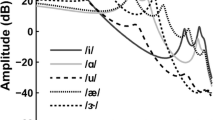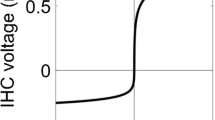Abstract
Vowels make a strong contribution to speech perception under natural conditions. Vowels are encoded in the auditory nerve primarily through neural synchrony to temporal fine structure and to envelope fluctuations rather than through average discharge rate. Neural synchrony is thought to contribute less to vowel coding in central auditory nuclei, consistent with more limited synchronization to fine structure and the emergence of average-rate coding of envelope fluctuations. However, this hypothesis is largely unexplored, especially in background noise. The present study examined coding mechanisms at the level of the midbrain that support behavioral sensitivity to simple vowel-like sounds using neurophysiological recordings and matched behavioral experiments in the budgerigar. Stimuli were harmonic tone complexes with energy concentrated at one spectral peak, or formant frequency, presented in quiet and in noise. Behavioral thresholds for formant-frequency discrimination decreased with increasing amplitude of stimulus envelope fluctuations, increased in noise, and were similar between budgerigars and humans. Multiunit recordings in awake birds showed that the midbrain encodes vowel-like sounds both through response synchrony to envelope structure and through average rate. Whereas neural discrimination thresholds based on either coding scheme were sufficient to support behavioral thresholds in quiet, only synchrony-based neural thresholds could account for behavioral thresholds in background noise. These results reveal an incomplete transformation to average-rate coding of vowel-like sounds in the midbrain. Model simulations suggest that this transformation emerges due to modulation tuning, which is shared between birds and mammals. Furthermore, the results underscore the behavioral relevance of envelope synchrony in the midbrain for detection of small differences in vowel formant frequency under real-world listening conditions.








Similar content being viewed by others
References
Aitkin LM, Phillips SC (1984) Is the inferior colliculus an obligatory relay in the cat auditory system? Neurosci Lett 44:259–264
Bartlett EL, Wang X (2007) Neural representations of temporally modulated signals in the auditory thalamus of awake primates. J Neurophysiol 97:1005–1017. doi:10.1152/jn.00593.2006
Baumann S, Griffiths TD, Sun L, Petkov CI, Thiele A, Rees A (2011) Orthogonal representation of sound dimensions in the primate midbrain. Nat Neurosci 14:423–425. doi:10.1038/nn.2771
Burger RM, Pollak GD (1998) Analysis of the role of inhibition in shaping responses to sinusoidally amplitude-modulated signals in the inferior colliculus. J Neurophysiol 80:1686–1701
Byrne D (1994) An international comparison of long-term average speech spectra. J Acoust Soc Am 96:2108. doi:10.1121/1.410152
Calford MB, Wise LZ, Pettigrew JD (1985) Coding of sound location and frequency in the auditory midbrain of diurnal birds of prey, families accipitridae and falconidae. J Comp Physiol A 157:149–160. doi:10.1007/BF01350024
Carney LH, Ketterer AD, Abrams KS, Schwarz DM, Idrobo F (2013) Detection thresholds for amplitude modulations of tones in budgerigar, rabbit, and human. Adv Exp Med Biol 787:391–398. doi:10.1007/978-1-4614-1590-9_43
Carney LH, Li T, McDonough JM (2015) Speech coding in the brain: representation of vowel formants by midbrain neurons tuned to sound fluctuations. Eneuro 2:1–12. doi:10.1523/ENEURO.0004-15.2015
Caspary DM, Palombi PS, Hughes LF (2002) GABAergic inputs shape responses to amplitude modulated stimuli in the inferior colliculus. Hear Res 168:163–173
Chen C, Rodriguez FC, Read HL, Escabí MA (2012) Spectrotemporal sound preferences of neighboring inferior colliculus neurons: implications for local circuitry and processing. Front Neural Circuits 6:62. doi:10.3389/fncir.2012.00062
Choi JH, Jung HK, Kim T (2006) A new action potential detector using the MTEO and its effects on spike sorting systems at low signal-to-noise ratios. IEEE Trans Biomed Eng 53:738–746. doi:10.1109/TBME.2006.870239
Day ML, Delgutte B (2013) Decoding sound source location and separation using neural population activity patterns. J Neurosci 33:15837–15847. doi:10.1523/jneurosci.2034-13.2013
Delgutte B, Kiang YS (1984) Speech coding in the auditory nerve: I. Vowel-like sounds. J Acoust Soc Am 75:866–878
Dooling RJ, Brown SD (1990) Speech perception by budgerigars (Melopsittacus undulatus): spoken vowels. Percept Psychophys 47:568–574
Dooling RJ, Searcy MH (1981) Amplitude modulation thresholds for the parakeet (Melopsittacus undulatus). J Comp Physiol A 143:383–388. doi:10.1007/BF00611177
Dooling RJ, Okanoya K, Brown SD (1989) Speech perception by budgerigars (Melopsittacus undulatus): the voiced-voiceless distinction. Percept Psychophys 46:65–71
Dooling RJ, Best CT, Brown SD (1995) Discrimination of synthetic full-formant and sinewave/ra-la/continua by budgerigars (Melopsittacus undulatus) and zebra finches (Taeniopygia guttata). J Acoust Soc Am 97:1839–1846
Dooling RJ, Lohr B, Dent ML (2000) Hearing in birds and reptiles. In: Dooling RJ, Fay RR, Popper AN (eds) Comparative hearing: birds and reptiles. Springer, New York, pp. 308–359
Egan JP (1975) Signal detection theory and ROC analysis. Academic Press, New York
Fant G (1960) Acoustic theory of speech production. Mouton, Hague, The Netherlands
George ELJ, Festen JM, Houtgast T (2006) Factors affecting masking release for speech in modulated noise for normal-hearing and hearing-impaired listeners. J Acoust Soc Am 120:2295–2311. doi:10.1121/1.2266530
Gershon ED, Wiener MC, Latham PE, Richmond BJ (1998) Coding strategies in monkey V1 and inferior temporal cortices. J Neurophysiol 79:1135–1144
Gleich O, Klump GM (1995) Temporal modulation transfer functions in the European starling (Sturnus vulgaris): II. Responses of auditory nerve fibers. Hear Res 82:81–92
Henry KS, Neilans EG, Abrams KS, Idrobo F, Carney LH (2016) Neural correlates of behavioral amplitude modulation sensitivity in the budgerigar midbrain. J Neurophysiol 115:1905–1916. doi:10.1152/jn.01003.2015
Hillenbrand J, Getty L a, Clark MJ, Wheeler K (1995) Acoustic characteristics of American English vowels. J Acoust Soc Am 97:3099–3111. doi:10.1121/1.411872
Honey C, Schnupp J (2015) Neural resolution of formant frequencies in the primary auditory cortex of rats. PLoS One 10:1–20. doi:10.1371/journal.pone.0134078
Jazayeri M, Movshon JA (2006) Optimal representation of sensory information by neural populations. Nat Neurosci 9:690–696. doi:10.1038/nn1691
Johnson JS, Yin P, O’Connor KN, Sutter ML (2012) Ability of primary auditory cortical neurons to detect amplitude modulation with rate and temporal codes: neurometric analysis. J Neurophysiol 107:3325–3341. doi:10.1152/jn.00812.2011
Joris PX, Yin TCT (1992) Responses to amplitude-modulated tones in the auditory nerve of the cat. J Acoust Soc Am 91:215–232. doi:10.1121/1.402757
Joris PX, Schreiner CE, Rees A (2004) Neural processing of amplitude-modulated sounds. Physiol Rev 84:541–577. doi:10.1152/physrev.00029.2003
Kewley-Port D, Watson CS (1994) Formant-frequency discrimination for isolated English vowels. J Acoust Soc Am 95:485–496. doi:10.1121/1.410024
Kewley-Port D, Burkle TZ, Lee JH (2007) Contribution of consonant versus vowel information to sentence intelligibility for young normal-hearing and elderly hearing-impaired listeners. J Acoust Soc Am 122:2365–2375. doi:10.1121/1.2773986
Kim KH, Kim SJ (2000) Neural spike sorting under nearly 0-dB signal-to-noise ratio using nonlinear energy operator and artificial neural-network classifier. IEEE Trans Biomed Eng 47:1406–1411. doi:10.1109/10.871415
Klatt DH, Klatt LC (1990) Analysis, synthesis, and perception of voice quality variations among female and male talkers.
Krishna BS, Semple MN (2000) Auditory temporal processing: responses to sinusoidally amplitude-modulated tones in the inferior colliculus. J Neurophysiol 84:255–273
Ladefoged P, Maddieson I (1996) The sounds of the World’s languages. Wiley-Blackwell, Hoboken, NJ
Langner G, Schreiner CE (1988) Periodicity coding in the inferior colliculus of the cat. I. Neuronal mechanisms. J Neurophysiol 60:1799–1822
Langner G, Albert M, Briede T (2002) Temporal and spatial coding of periodicity information in the inferior colliculus of awake chinchilla (Chinchilla Laniger). Hear Res 168:110–130. doi:10.1016/S0378-5955(02)00367-2
Levitt H (1970) Transformed up-down methods in psychoacoustics. J Acoust Soc Am 49:467–477
Lim HH, Lenarz T (2015) Auditory midbrain implant: research and development towards a second clinical trial. Hear Res 322:212–223. doi:10.1016/j.heares.2015.01.006
Lyzenga J, Horst JW (1995) Frequency discrimination of bandlimited harmonic complexes related to vowel formants. J Acoust Soc Am 98:1943–1955
Lyzenga J, Horst JW (1997) Frequency discrimination of stylized synthetic vowels with a single formant. J Acoust Soc Am 102:1755–1767
Lyzenga J, Horst JW (1998) Frequency discrimination of stylized synthetic vowels with two formants. J Acoust Soc Am 104:2956–2966. doi:10.1121/1.423878
Macmillan NA, Creelman CD (2005) Detection theory: a user’s guide.
Manley GA (2010) An evolutionary perspective on middle ears. Hear Res 263:3–8. doi:10.1016/j.heares.2009.09.004
Manley GA, Gleich O, Leppelsack HJ, Oeckinghaus H (1985) Activity patterns of cochlear ganglion neurones in the starling. J Comp Physiol A 157:161–181. doi:10.1007/BF01350025
Mao J, Carney LH (2015) Tone-in-noise detection using envelope cues: comparison of signal-processing-based and physiological models. J Assoc Res Otolaryngol 16:121–133. doi:10.1007/s10162-014-0489-1
Mesgarani N, David SV, Fritz JB, Shamma SA (2008) Phoneme representation and classification in primary auditory cortex. J Acoust Soc Am 123:899. doi:10.1121/1.2816572
Nelson PC, Carney LH (2004) A phenomenological model of peripheral and central neural responses to amplitude-modulated tones. J Acoust Soc Am 116:2173–2186. doi:10.1121/1.1784442
Nelson PC, Carney LH (2007) Neural rate and timing cues for detection and discrimination of amplitude-modulated tones in the awake rabbit inferior colliculus. J Neurophysiol 97:522–539. doi:10.1152/jn.00776.2006
Perez CA, Engineer CT, Jakkamsetti V, Carraway RS, Perry MS, Kilgard MP (2013) Different timescales for the neural coding of consonant and vowel sounds. Cereb Cortex 23:670–683. doi:10.1093/cercor/bhs045
Ramachandran R, Davis KA, May BJ (1999) Single-unit responses in the inferior colliculus of decerebrate cats. I. Classification based on frequency response maps. J Neurophysiol 82:152–163
Rees A, Palmer AR (1989) Neuronal responses to amplitude-modulated and pure-tone stimuli in the Guinea pig inferior colliculus, and their modification by broadband noise. J Acoust Soc Am 85:1978–1994
Rhode WS, Greenberg S (1994) Encoding of amplitude modulation in the cochlear nucleus of the cat. J Neurophysiol 71:1797–1825
Robbins H, Monro S (1951) A stochastic approximation method. Ann Math Stat 22:400–407
Rosen MJ, Semple MN, Sanes DH (2010) Exploiting development to evaluate auditory encoding of amplitude modulation. J Neurosci 30:15509–15520. doi:10.1523/JNEUROSCI.3340-10.2010
Ryugo DK, Parks TN (2003) Primary innervation of the avian and mammalian cochlear nucleus. Brain Res Bull 60:435–456. doi:10.1016/S0361-9230(03)00049-2
Sachs MB, Young ED (1980) Effects of nonlinearities on speech encoding in the auditory nerve. J Acoust Soc Am 68:858–875
Sachs MB, Young ED, Lewis RH (1974) Discharge patterns of single fibers in the pigeon auditory nerve. Brain Res 70:431–447
Sachs MB, Voigt HF, Young ED (1983) Auditory nerve representation of vowels in background noise. J Neurophysiol 50:27–45
Sayles M, Füllgrabe C, Winter IM (2013) Neurometric amplitude-modulation detection threshold in the Guinea-pig ventral cochlear nucleus. J Physiol 591:3401–3419. doi:10.1113/jphysiol.2013.253062
Seshagiri CV, Delgutte B (2007) Response properties of neighboring neurons in the auditory midbrain for pure-tone stimulation: a tetrode study. J Neurophysiol 98:2058–2073. doi:10.1152/jn.01317.2006
Tan Q, Carney LH (2005) Encoding of vowel-like sounds in the auditory nerve: model predictions of discrimination performance. J Acoust Soc Am 117:1210–1222. doi:10.1121/1.1856391
Woolley SMN, Casseday JH (2005) Processing of modulated sounds in the zebra finch auditory midbrain: responses to noise, frequency sweeps, and sinusoidal amplitude modulations. J Neurophysiol 94:1143–1157. doi:10.1152/jn.01064.2004
Woolley SMN, Portfors CV (2013) Conserved mechanisms of vocalization coding in mammalian and songbird auditory midbrain. Hear Res 305:45–56. doi:10.1016/j.heares.2013.05.005
Yin P, Johnson JS, O’Connor KN, Sutter ML (2011) Coding of amplitude modulation in primary auditory cortex. J Neurophysiol 105:582–600. doi:10.1152/jn.00621.2010
Young ED, Sachs MB (1979) Representation of steady-state vowels in the temporal aspects of the discharge patterns of populations of auditory- nerve fibers. J Acoust Soc Am 66:1381–1403
Zhang H, Kelly JB (2003) Glutamatergic and GABAergic regulation of neural responses in inferior colliculus to amplitude-modulated sounds. J Neurophysiol 90:477–490. doi:10.1152/jn.01084.2002
Zilany MSA, Bruce IC, Carney LH (2014) Updated parameters and expanded simulation options for a model of the auditory periphery. J Acoust Soc Am 135:283–286. doi:10.1121/1.4837815
Acknowledgments
This work was supported by National Institutes of Health Grants R01-DC001641 to L.H.C. and R00-DC013792 to K.S.H. Mitchell L. Day provided analysis code for calculating the discrimination performance of optimally pooled neural populations.
Author Contributions
KSH, JF, FI, and LHC designed the research; KSH, KSA, MJM, and EGN performed the experiments; KSH, KSA, MJM, FI, and LHC analyzed the data; and KSH wrote the manuscript.
Author information
Authors and Affiliations
Corresponding author
Ethics declarations
Conflict of Interest
The authors declare that they have no conflict of interest.
Rights and permissions
About this article
Cite this article
Henry, K.S., Abrams, K.S., Forst, J. et al. Midbrain Synchrony to Envelope Structure Supports Behavioral Sensitivity to Single-Formant Vowel-Like Sounds in Noise. JARO 18, 165–181 (2017). https://doi.org/10.1007/s10162-016-0594-4
Received:
Accepted:
Published:
Issue Date:
DOI: https://doi.org/10.1007/s10162-016-0594-4




